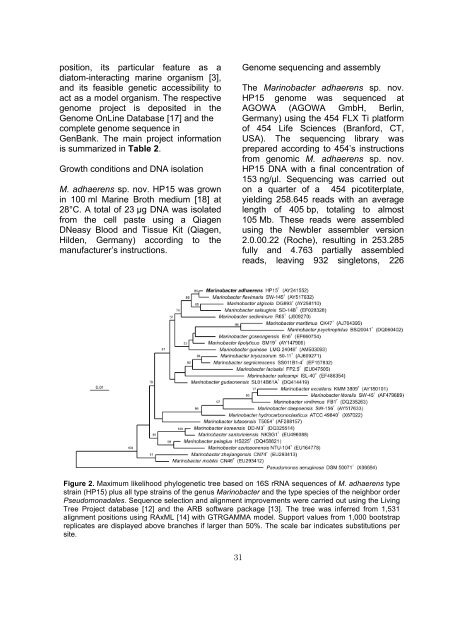h tQMQKB+ M/ ;2M2iB+ M HvbBb Q7 J `BMQ# + ... - Jacobs University
h tQMQKB+ M/ ;2M2iB+ M HvbBb Q7 J `BMQ# + ... - Jacobs University
h tQMQKB+ M/ ;2M2iB+ M HvbBb Q7 J `BMQ# + ... - Jacobs University
You also want an ePaper? Increase the reach of your titles
YUMPU automatically turns print PDFs into web optimized ePapers that Google loves.
position, its particular feature as a<br />
diatom-interacting marine organism [3],<br />
and its feasible genetic accessibility to<br />
act as a model organism. The respective<br />
genome project is deposited in the<br />
Genome OnLine Database [17] and the<br />
complete genome sequence in<br />
GenBank. The main project information<br />
is summarized in Table 2.<br />
Growth conditions and DNA isolation<br />
M. adhaerens sp. nov. HP15 was grown<br />
in 100 ml Marine Broth medium [18] at<br />
28°C. A total of 23 !g DNA was isolated<br />
from the cell paste using a Qiagen<br />
DNeasy Blood and Tissue Kit (Qiagen,<br />
Hilden, Germany) according to the<br />
manufacturer’s instructions.<br />
Genome sequencing and assembly<br />
The Marinobacter adhaerens sp. nov.<br />
HP15 genome was sequenced at<br />
AGOWA (AGOWA GmbH, Berlin,<br />
Germany) using the 454 FLX Ti platform<br />
of 454 Life Sciences (Branford, CT,<br />
USA). The sequencing library was<br />
prepared according to 454’s instructions<br />
from genomic M. adhaerens sp. nov.<br />
HP15 DNA with a final concentration of<br />
153 ng/!l. Sequencing was carried out<br />
on a quarter of a 454 picotiterplate,<br />
yielding 258.645 reads with an average<br />
length of 405 bp, totaling to almost<br />
105 Mb. These reads were assembled<br />
using the Newbler assembler version<br />
2.0.00.22 (Roche), resulting in 253.285<br />
fully and 4.763 partially assembled<br />
reads, leaving 932 singletons, 226<br />
Figure 2. Maximum likelihood phylogenetic tree based on 16S rRNA sequences of M. adhaerens type<br />
strain (HP15) plus all type strains of the genus Marinobacter and the type species of the neighbor order<br />
Pseudomonadales. Sequence selection and alignment improvements were carried out using the Living<br />
Tree Project database [12] and the ARB software package [13]. The tree was inferred from 1,531<br />
alignment positions using RAxML [14] with GTRGAMMA model. Support values from 1,000 bootstrap<br />
replicates are displayed above branches if larger than 50%. The scale bar indicates substitutions per<br />
site.
















